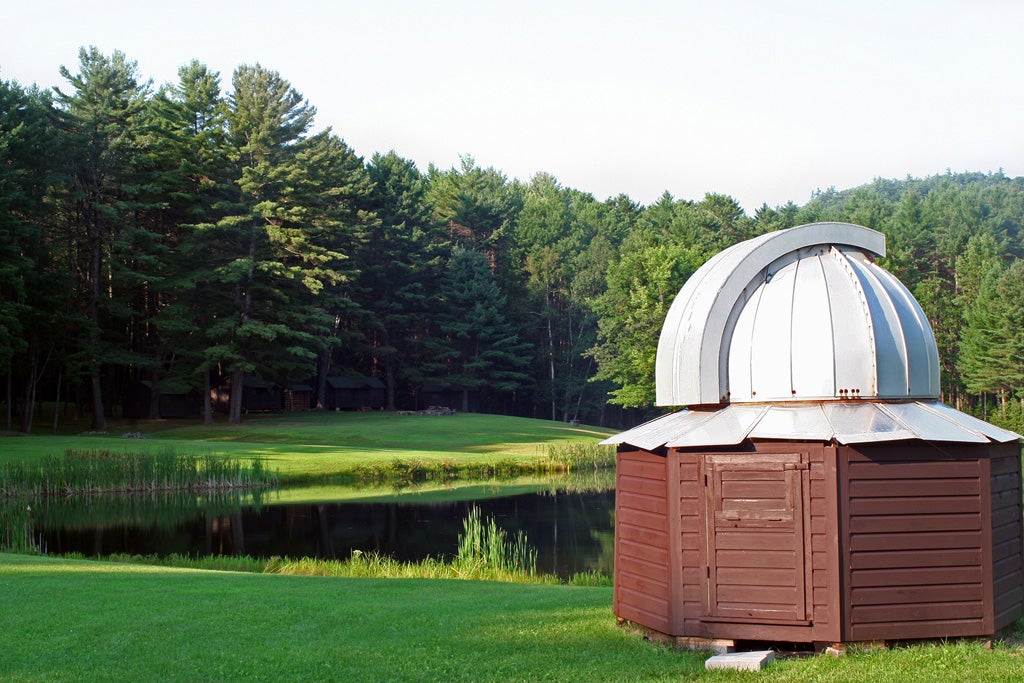
In just a few months, the eighth annual Adirondack Astronomy Retreat will open its gates. My wife and I run this informal observing retreat in the Adirondack Mountains, and this year will feature two sessions: the first lasts from July 29 to August 1, and the second from August 2–5.
The site of the retreat — State University of New York (SUNY) Plattsburgh’s Twin Valleys Camp — boasts one of the darkest skies in the northeast. The only light pollution is far to the east, across Lake Champlain, from Burlington, Vermont. Even this faint glow is only barely brighter than it was in the 1960s, when I occasionally visited. The Adirondack forest still protects the sky from much of this glow, leaving the area truly one of the darkest in eastern North America. Looking in the opposite direction, to the southwest, all you see is black sky high above the peaks of the mighty Adirondacks.
This place grows on its campers. I first visited the site at the start of the summer of 1964. My diary entry for the first day reads, “It is a nice camp and I guess I like it.” Next day: “This camp’s OK.” Third day: “It’s a fantastic camp.” I spent three wonderful summers there. The second summer helped me decide to begin a comet-hunting program that continues to this day; it’s led to the discovery of 23 comets, including the Jupiter impactor Shoemaker-Levy 9.
I returned to the camp in 2003 with William Ehmann, who ran the site for SUNY Plattsburgh at the time, when I developed the idea to host a retreat there. The beauty and peace of this camp was just too lovely to pass up.
Our retreat this past summer was one of the best yet. We were lucky with the weather, enjoying all but one night of clear skies. Even better, for the first time since the retreats began in 2004, we finally had a small dome for a new 14-inch Schmidt-Cassegrain telescope. Meade Instruments and the Sharing the Sky Foundation donated the scope, and the dome came courtesy of the Cutting family, who had used it for many years. Gerard Cutting and his sons built the structure at his observatory in Whitehall, New York. We inherited it, along with his library and other astronomical items, after Cutting passed away in 2008. The new observatory quickly became an integral part of the camp.
We took advantage of our yearly “VIP night” — which in 2010 featured a talk from representatives of the SUNY community — to host a special ceremony on August 7, 2010, to mark the opening of the Cutting Pavilion. It’s not a huge dome, but it marked the first construction on this site in more than 40 years. We welcomed the Cuttings as honorary members of our retreat family. During the next few nights, we counted hundreds of Perseid meteors and enjoyed the opportunity to expand our deep-sky horizons.
The retreat’s dark skies offer amazing sights to go along with the setting’s soothing sounds. For instance, one night last summer I saw the great Pinwheel Galaxy (M33) in Triangulum with my naked eye. During such dark nights, the lovely “Who cooks for you…uuuuu” call of the spotted owls who share the site with us often rings through the air. In the wild, these owls can live up to a decade; maybe the calls I heard last year are from the great-grandchildren of my avian companions from more than 40 years ago.
The best thing about this event is that the people who attend — most of them every year — are like family. “You really feel a special magic in this place,” Peter Jedicke told me once about a sky that has changed little in four decades. “I wouldn’t miss it for anything.” You can find more information at www.adirondackastronomyretreat.org, or simply write us at info@sharingthesky.org. We’d love it if you could join us this summer and truly rediscover, in this peaceful valley, why you came to love the night sky in the first place.









